First impressions are everything. How much does a uniform play in the success of the team’s performance on the field?
There have been so many uniform changes in the past, but the ones that fall in the parameters of this article are ignited by a name change or a move to a new city. No changes in uniforms “just because” in this discussion, or we could be here all day.
As you might have heard, the Cleveland Guardians are here. Despite the kicking and screaming from some, name changes are common in Cleveland baseball history. Granted the last one stuck since 1915, but that’s beside the point. Between 1884-1915, Cleveland baseball had five different surnames. We went from the Grand Rapids Rippers, the Lake Shores, Blues, Bronchos, to the Naps before landing on the Indians.
The Cleveland organization had an interesting opportunity in front of them going into the 2022 season. The name change was inevitable (and needed) but they had the choice to potentially rebrand the whole organization—colors and all. The Guardians passed on that opportunity and elected to keep with Cleveland’s rich tradition of baseball.
The uniforms look largely identical to the year prior except for the name and the font on the front differs:
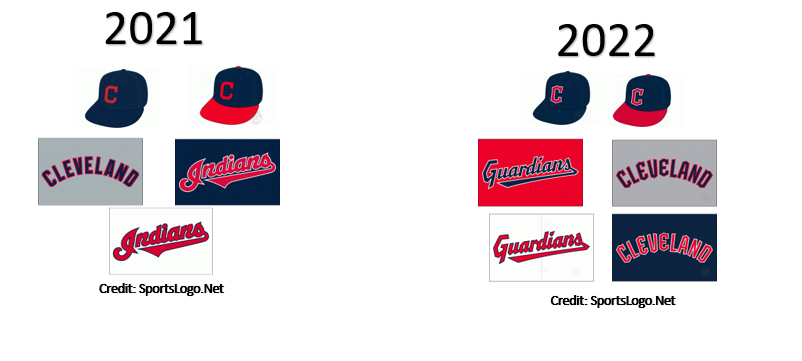
If you missed it, the Guardians’ uniforms look similar to the teams we are used to of the past. Going back to when they first became the Indians in 1915, a variation of blue, red, and white have been the colors of baseball near Lake Erie. The script on the front is not just a random flashy font—it was purposeful. It’s familiar, but tweaked. Both the block C logo on the hat and the wordmark on the front of the jersey were purposefully made to represent the Hope Memorial Bridge, which the guardians of traffic stand atop a stone’s throw from the gates of Progressive Field.
The team’s road uniforms will still say CLEVELAND on the front with a minimally altered style.
Baseball fans typically do not handle change well, which is why we have the Guardians taking it slow. The name was hard enough for most to adjust to so they did a great job of honoring their history and moving on from the past. It’s possible or a more extreme makeover could happen down the line but not yet. If it was not for the four different letters in script on the front of the jerseys, some may not have noticed.
Same City, New Name
Pouring through the history of Major League Baseball, it is challenging to find a situation exactly like the one Cleveland found themselves in. The only other time a team was forced (or strongly urged) to change their name was when Tampa Bay had to rebrand into the Rays from the Devil Rays. Like Cleveland’s outcry to change their name from the Indians, the people in the Tampa Bay area were not fond of having the name Devil in the original team name.
“Though the “Devil” part of the name was because of the rays found in the Tampa Bay area, some people had issues with the word in the team’s name. After nearly a decade as the Devil Rays, and countless phone calls pleading with the team to change the name, the team’s new ownership, led by current owner Stuart Sternberg, decided that it was best to change the name to the Tampa Bay Rays. That change happened after the 2007 season.” (MLB)

Tampa Bay took a whole different approach than Cleveland did. With the name change came a complete rebranding from logos to the color scheme: You name it, they altered it. The only thing left was the small sleeve patch reminiscent of a time gone by. The willingness to upheave their whole identity probably had to do with the fact that the Rays were only 10 years old at the time of change and had done nothing but lose up until that point. Comparing that to the 100+ year history of Indians’ name is almost not fair, but the rebrand in Tampa was well-received nonetheless. You can pinpoint that time in history when the Rays changed their uniforms as when they started to win. Coincidence?
New City, New Look?
This got me thinking about teams that moved in the past. Some teams moved cities yet retained their exact name. Change eventually became more drastic with more time separated from the original movie.
What were those uniforms like the first year moving cities? Did the uniforms change dramatically? Let’s go in chronological order:
1953: Braves play their first season in Milwaukee
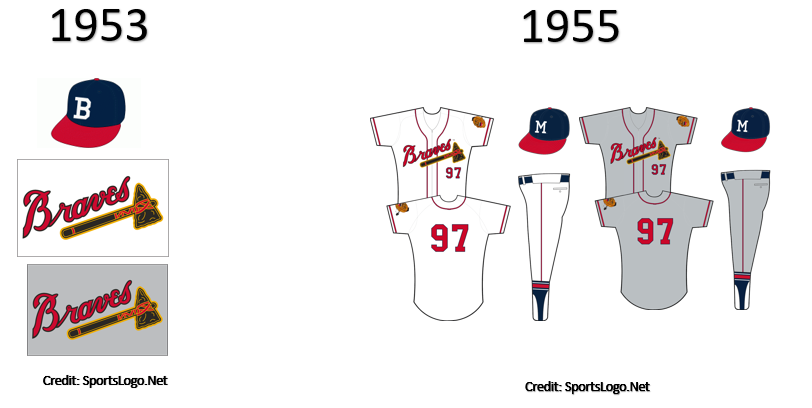
In a weird period, the Red Sox were not the only team in Boston playing baseball. It was not easy playing in Boston and being the younger brother. Due to attendance issues, ownership packed their bags and sought greener pastures in Milwaukee. Talk about an easy change. The jerseys stayed the same and the hat was altered slightly from a B to an M. You can even see the current Braves’ uniforms in this one. Why change a classic? It’s cool to trace the lineage.
“They were always the second-class citizens,” said Bob Brady, president of the Boston Braves Historical Association, based in Chestnut Hill, Massachusetts. “When the Braves franchise first came into existence, they had Boston’s attention, but when the American League was founded in 1901, the fan base largely shifted toward the Sox, and stayed that way.” (Providence Journal)
1954: St. Louis Browns move to Baltimore Orioles
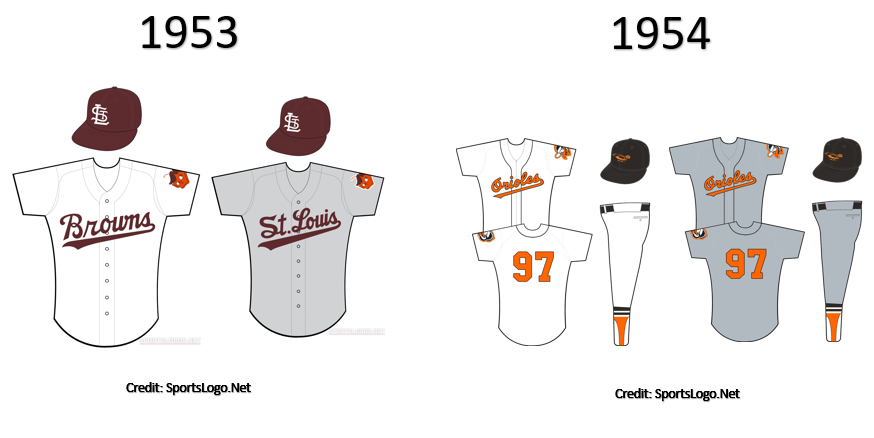
This was a complete rebrand as you can see from the names. The Orioles kept a very similar color scheme as the Browns. St. Louis, long heralded as a baseball hub, could not handle two teams. So much so that people do not even realize that in 1941, the Browns had their bags packed for Los Angeles to be the first West Coast professional baseball team. The Browns’ front office was so sure that they were taking up shop in LA that they had invited video cameras and a press conference at Lyman’s Café. They were an official vote away from heading west 15 years before the Dodgers & Giants ever did so.
1955: Athletics move from Philadelphia to Kansas City
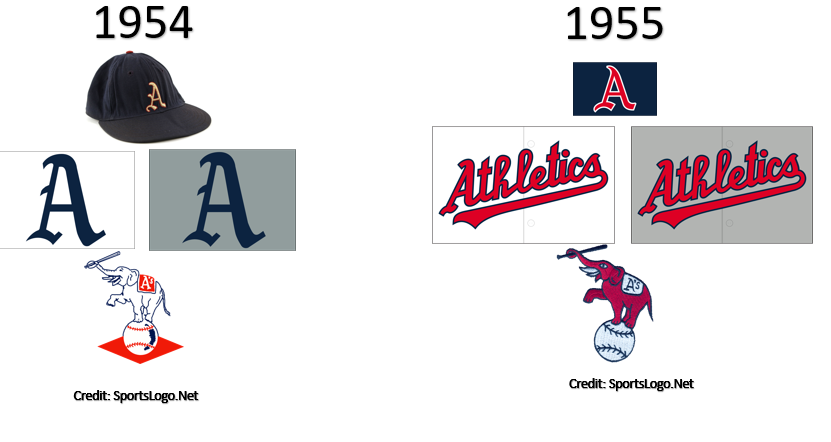
Philadelphia used to be the home to two teams, but much like Boston and St. Louis prior, they were unable to field enough fans at the gate to justify keeping them there. With money issues, a struggling pool of up-and-coming prospects, and the Phillies taking over the market around 1950, all of it kept fans away from Shibe Park. The attendance issues sent the Athletics to Kansas City which resulted in a uniform alteration as well.
1958: Giants move from New York to San Francisco
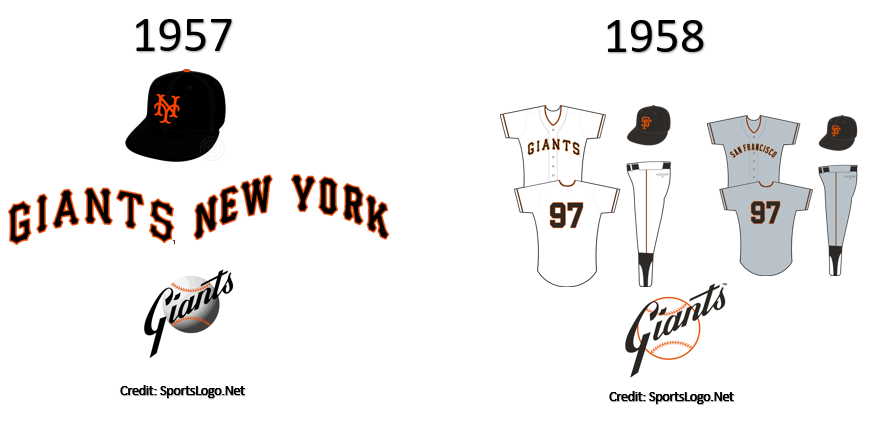
It was a perfect storm for the Giants to leave New York. Attendance eventually became an issue and, paired with losing season, it became a mounting problem that snowballed because they were trying to find a new stadium to replace the aging Polo Grounds. The attendance issues were baffling because they were not too far removed from fielding a World Series Champion team. With New York’s reluctance to build a new stadium, the franchise started to seriously consider leaving Manhattan. Their original destination was not always San Francisco—it could have been Minnesota.
The Giants’ front office was considering Minnesota because the Minneapolis Millers were their top farm team at the time. It fell through but ultimately could have happened because they had priority rights due to the Millers existing there. The owner of the Giants at the time, Stoneham, has been said to have been faking interest in Minnesota as a bargaining ploy to get a better deal.
With Dodgers having some momentum to leave Brooklyn for Los Angeles, there was a surge of interest from the San Francisco market to have a tag team partner at their side upon arrival. The Giants had their ear bent by the mayor of San Francisco to discuss the Giants found a new home in the Golden State. Diving deeper, rumor has it that the Dodgers were told that they would not be permitted to move to Los Angeles unless a second team packed their bags with them.
The Giants kept their uniforms largely the same upon the 1958 season in San Francisco, aside from the logo that was changed on the cap.
1958: Dodgers move from Brooklyn to Los Angeles
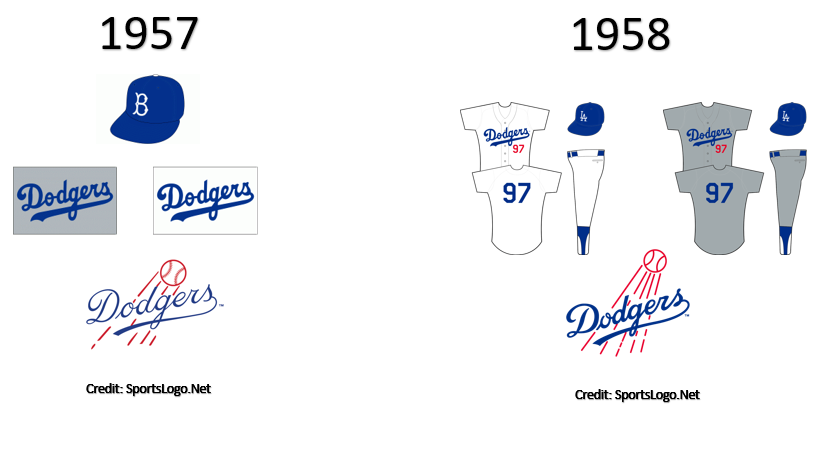
The Dodgers move was the catalyst for the Giants moving, but maybe they aided each other in building momentum. Walter O’Malley purchased a quarter of the franchise and he had eyes out for a brand new facility or even sending the team out West from the beginning. There’s no denying he was driven by the dollar signs.
The Dodgers proposed a state-of-the-art stadium to be located in Brooklyn, which seemed like it would be happening. Everyone was on board except for Robert Moses, who had a lot of sway in those days. He was not a fan of the idea of building another stadium in Brooklyn due to the traffic it could cause. He proposed building a new stadium near where the eventual Mets took home in Queens.
Everyone knows the story from there: O’Malley turned down the deal and started fielding serious considerations from other cities. Los Angeles was where they bolted to.
The Dodgers’ uniforms were largely the same minus the hat change. Why change a classic?
1961: Washington Senators move to Minnesota Twins

Another complete rebrand and one of the better ones. They kept the colors and a variation of the font. Minnesota was used as a bargaining chip in the California dealings, but they finally got their team in 1961 when the Senators folded. Stop me if you’ve heard this already, but attendance issues sent the Senators to Minnesota which created the Twins. These uniforms were a thing of beauty.
1967: Milwaukee Braves move to Atlanta
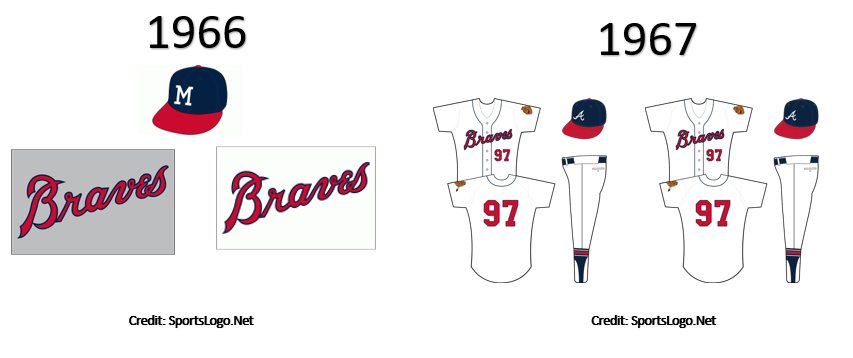
The Braves are on the move again. Again we saw a franchise move due to the attendance issues. They were fielding a winner in Milwaukee, so the front office was upset that the team was not drawing as well. Milwaukee was a baseball city but the Braves never gripped the city the way the Brewers eventually did.
The move to Atlanta did not happen without issue. Their move from Boston happened quietly, but maybe that was because the city was not losing both of their teams, just one. Milwaukee did not want the Braves to leave as they were a large portion of the city’s income and they had fought so hard to get a baseball team there in the first place.
The city of Milwaukee tried to tie them up in court, but was unsuccessful. The Braves played their first season in Atlanta in 1967.
The Braves eventually became something like America’s team and eventually donned red, white, and blue uniforms to support that new nickname which happened in 1972.
1968: Athletics move from Kansas City to Oakland
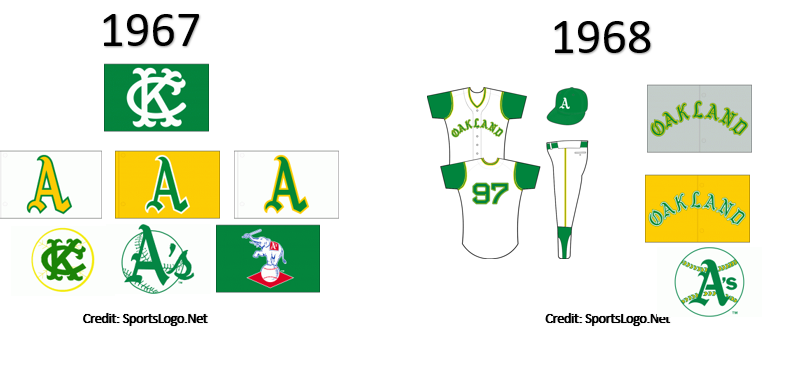
The Athletics were not long for Kansas City. You can blame this on owner Charles Finley or whoever. He was a headache for all of the other owners. He was not well-liked and he seemed persistent to leave Kansas City no matter what. He did not have a television deal in place for Oakland but that was the move he wanted.
The team continued to struggle on the field which in turn damaged the attendance. Finley seemed to be trying to lose to force his way out of town. Think of the premise of Major League where the ownership team was trying to move the Indians from Cleveland to Miami. The owners were on board with it, but officials got involved to keep the team in Kansas City because they would have an empty stadium without a team. The American League had already been discussing expansion in different cities, so they rushed to put together presentations from Seattle and Texas. Months later, the relocation of the Athletics to Oakland was approved all while the American League awarded franchises to Kansas City and Seattle to begin to play in 1969. The Royals were in—the Athletics were out.
Let’s take a look at the change in uniform. The color scheme we see in Oakland today was a slow burn and indeed was around at their finale in Kansas City.
1970: Seattle Pilots moved to Milwaukee Brewers
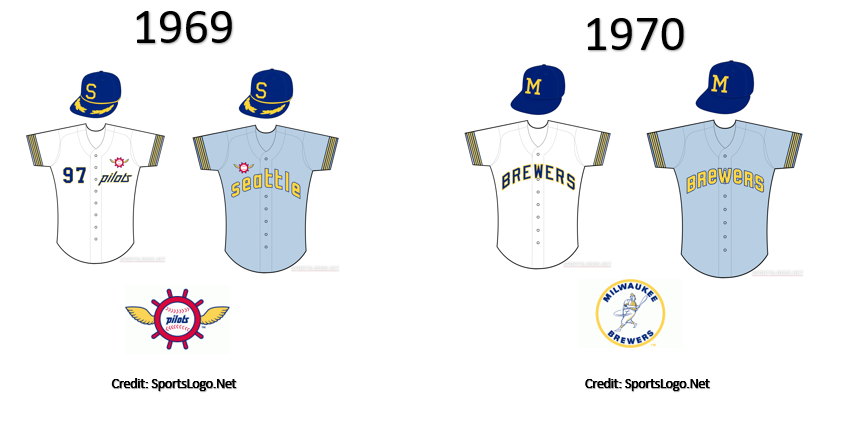
Remember that expansion team that was awarded to Seattle? Well, it only lasted a year. Yikes. Milwaukee got their franchise back and took the rights to the expansion Seattle Pilots franchise that was still essentially in their infancy. It would be seven years until we would see professional baseball in Seattle again. Full rebrand again, so let’s check out the change in uniforms. The color scheme was the same and you can see the Brewers’ original concept was based loosely on the Pilots whether they admit it or not.
1972: Washington Senators move to Texas Rangers

MLB was convinced that baseball could work again in Washington DC. It did last 1o years before they up and left the DC fans holding the bag again when they moved to Texas to begin to play as the Rangers. This was a combination of the allure of Texas getting a team and the DC fans not showing up. Check out the change in uniforms for the completely rebranded Texas Rangers.
2005: Montreal Expos move to Washington Nationals

We all know the heartbreaking story of Montreal losing their franchise. This is the most recent example of a team changing cities and fans being left heartbroken. You can blame Jeffrey Loria, the 1994 MLB Strike, or lack of revenue sharing to keep players, but it does not matter where the fingers can be pointed—it happened. The mass exodus of their best players in a cost-cutting measure to get the payroll down murdered the team essentially. The product on the field suffered and the attendance followed suit.
Uniforms Have a Lineage
The most interesting part of this exercise was seeing the influence that each team’s history had on the franchise they would become. The evolution of uniforms is mesmerizing and you could teach a credit-bearing college course on the effect of jerseys on the game.
It would be fascinating to see if any colors bear more wins than others. I’m certain those numbers could be produced. As one example, you can certainly trace the moment of rebranding as a pivotal point in Tampa Bay’s success. Whether it has something to do with the uniforms is a debate for another day.
It’s worth conjecture but at the end of the day, it’s safe to assume–you look good, you feel good. And if you feel good, you play well.
Featured image by Shawn Palmer (@Palmerdesigns_ on Twitter)

